Paul Taylor’s American Modern Dance presents it New York season, March 15-April 3.
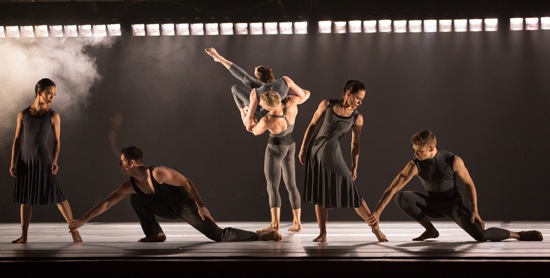
Larry Keigwin’s Rush Hour performed by Paul Taylor dancers. (L to R): Madelyn Ho, Robert Kleinendorst, Michael Trusnovec, Heather McGinley, Eran Bugge, and Michael Novak. Photo: Yi-Chun Wu
Last year inaugurated the transformation of the Paul Taylor Dance Company into Paul Taylor’s American Modern Dance. During that season, Shen Wei’s Rite was performed by his own company, and the José Limón company danced Doris Humphrey’s Passacaglia and Fugue in C minor. During the company’s current two-week season at Lincoln Center, it’s the Taylor dancers who perform the world premieres of Larry Keigwin’s Rush Hour and Doug Elkins’s Weight of Smoke, as well as Martha Graham’s 1949 Diversion of Angels. The only guest ensemble is the Dayton Contemporary Dance Company performing Donald McKayle’s 1959 classic, Rainbow ‘Round My Shoulder. All this in addition to fourteen of Taylor’s dances, both great and small, plus two brand new ones.
Over the course of his long career, he has made a number of goofy dances, but he always puts a wry twist on them. One of his premieres this season is Dilly Dilly, set to folk songs rendered by Burl Ives. Maybe Taylor happened upon Ives via youTube, but he could also have just pulled an old 10-inch LP record from his stash. Ives was singing and picking folk music and songs for children well before the folk music craze of the 1950s. His high, unaffected, silky-smooth voice fit his taste in songs (no raunchy verses), and his playfulness (plus his movie career) made him popular.
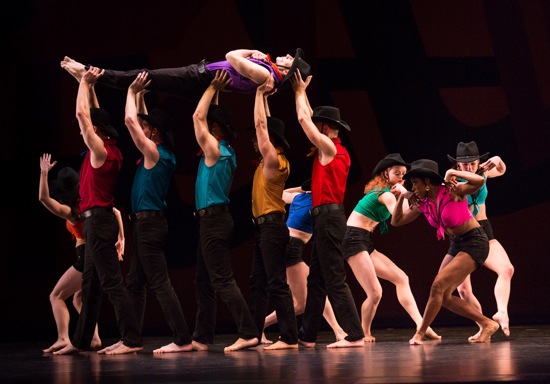
Paul Taylor’s Dilly Dilly. Robert Kleinendorst carried away, while (L to R) Heather McGinley, Michelle Fleet, and Laura Halzack rejoice. Photo: Yi-Chun Wu
Taylor drew his title from “Lavender’s Blue,” the song that opens the dance. Its roots are in England, but, surprise! Santo Loquasto has costumed eleven Taylor dancers as show-biz cowboys and cowgirls. I say “show-biz,” because the bright-colored shirts are sleeveless; also, the women’s midriffs are bared and their black jeans so short that sitting on a horse might be painful. Everyone wears a hat. The dancers move in and of the lines and circles of a reel. The women hold imaginary reins and giddyap, and the men slap their own butts in lieu of a horse’s rump when they gallop in formation.
There’s not just one “blue tail fly” in the dance that Taylor has concocted to the song of that name; he employs a whole fleet of darting, hand-rubbing aggressors. Robert Kleinendorst is busy with Eran Bugge when Michelle Fleet chomps down on his arm. He dies, of course. So does Heather McGinley, who’s hanging on Sean Mahoney, as he tries to keep her from “the foggy, foggy dew.” She succumbs anyway and is hoisted and carried off amidst lamenting. Then there’s Frankie and Johnny—not the happiest of lovers. In a largely pantomimic number, Johnny (Michael Trusnovec) makes out with handy Nelly Bly (Jamie Rae Walker); and Frankie (Laura Halzack) “borrows” a gun from the bartender (Kleinendorst) and shoots the rat. Trusnovec’s prolonged death throes are a marvel.
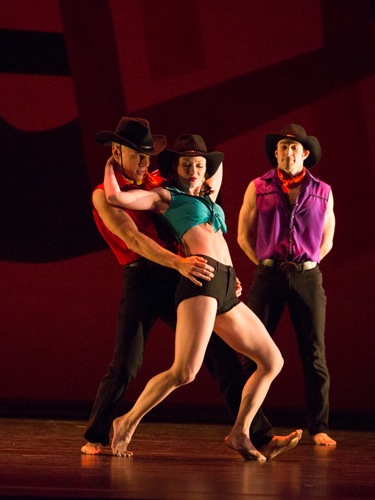
“Johnny” (Michel Trusnovec) and his “Frankie” (Laura Halzack) watched by “bartender” Robert Kleinendorst in Paul Taylor’s Dilly Dilly. Photo: Yi-Chun Wu
So are Michael Novak’s frog jumps in “Mr. Froggie Went A-Courtin’.” as he follows not one “Miss Mousey” but three simpering girlfriends (McGinley, Walker, and Michelle Fleet); they lead him inevitably to an unseen offstage “snake” who gulps them all down (Ives’s tricks on the guitar must have delighted every child who heard him deliver this song). Three men (Novak, James Samson, and Francisco Graciano) buddy-up and trade punches to “The Doughnut Song” with its hornpipe friskiness and sound advice re the walk through life: “Watch the doughnut, not the hole.” And Fleet, Mahoney, and Graciano lead the way into “Big Rock Candy Mountain,” at the end of which all the dancers huddle to form that very peak. Dilly Dilly isn’t a dance for the ages, but it goes down like ice cream on a hot day and drew laughs and delighted applause from the opening-night’s packed house.
I’d like to have been a flyy on the wall when Taylor and Loquasto decided on costumes and hairdos for Sullivaniana, which premiered on the second night of the season. They are visual knockouts, of course, and in keeping with the aura conveyed by the rollicking overtures to three Gilbert and Sullivan light operas: Iolanthe, Pirates of Penzance, and Patience (orchestra conducted by Tong Chen). The five women wear high heels and individually colored dresses that, although knee-length, echo the corseted look of 1870s and 1880s fashions. The men wear shoes, hats, trousers, and plaid frock coats in various colors. Traces of plaid also appear on the women.
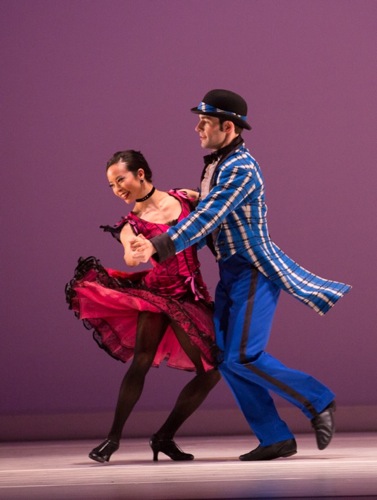
Madelyn Ho and Robert Kleinendorst in Paul Taylor’s Sullivaniana. Photo: Yi-Chun Wu
Loquasto has created a faux proscenium arch with its lit bulbs, and everything that happens within it, and in the theatrical lighting devised by James F. Ingalls, is decorous, if slightly askew. There’s only one woman in sight (the vivid, diminutive newcomer, Madelyn Ho). “Where can he be?” she seems to be saying, as she looks into the wings, her body taut with expectation. Or maybe, “Where is everybody?” Her small gestures and rushes here and there could refer back to the calls of “Io-lanthe, Io-lanthe!” that we hear in the music. Her not-giving-up solo lasts for so long that it prepares us for comedy. She does give up, however, before George Smallwood enters. He too is looking for someone or something. For quite a while, ardently-seeking dancers run and leap across the stage and disappear in all directions.
A mild shock comes when Bugge’s high heels and ruffled dress don’t prevent her from turning a back somersault before skipping offstage. In no time, more women are sinking to the floor and rolling around, petticoats be damned. That’s what I mean about the costume-movement disconnect. Men doing a back flip into the wings or turning a cartwheel (without losing their hats) seems only slightly less strange.
Lifts are endemic to the choreography, including one of Taylor’s favorites: men carrying women in their arms as if they were taking sleeping kids up to bed. Kleinendorst executes a more dazzling hoist in the Bolshoi Ballet style—holding Ho above his head with one straight arm and whirling offstage with her. Parisa Khobdeh wards off Smallwood: no more lifts, mister!
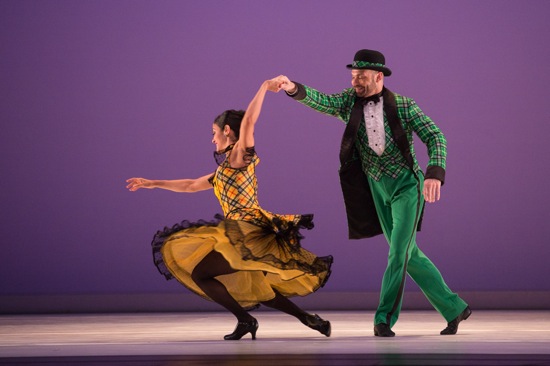
Parisa Khobdeh and George Smallwood in Paul Taylor’s Sullivaniana. Photo: Yi-Chun Wu
Eventually couples join in a waltz or participate in a slow-motion reel. Sometimes, people look at one another in a what’s-next manner. To a summons in the music, they start leaping every which-way, and the stage picture gets a bit messy. Mess is unusual for Taylor, but he’s making a point, I think. Kleinendorst falls and crawls offstage. Before you know it, all ten dancers are piling on top of one another in a mountain-shaped orgy. They recover to march some more and leave the parade gradually, one or several at a time, until Ho is again onstage alone, still marching. Her leap into the wings incites a blackout and a descending curtain.
Gilbert and Sullivan’s pirates, soldiers, maidens, and peers of the realm crop up in these overtures—their stories buried, but their melodies and rhythms persisting and jostling together. The late 19th-century composer and lyricist parodied many aspects of their era’s politics and artistic movements. Taylor plays his own games with their tunes. What have his dressed-up dancers been looking for, and do they ever find it? I allowed myself to imagine them as an overture in search of the expected opera and finally deciding the hell with W.S. Gilbert’s still-to-come plot.
The second-night audience rose to its feet to cheer Keigwin’s Rush Hour, and no wonder. The brilliantly designed work, set to a commissioned score by Adam Crystal, gets your pulse racing. It makes use of all sixteen Taylor dancers, without foregrounding any one of them for long. Fritz Masten has costumed them in interestingly designed black and gray attire. Clifton Taylor’s lighting includes a bit of fog, beams angling down the rear wall, and a horizontal bar of lamps (also near the back) suspended above the stage. The floor is white and divided into sections. The dark rear of the space swallows up any who congregate there.
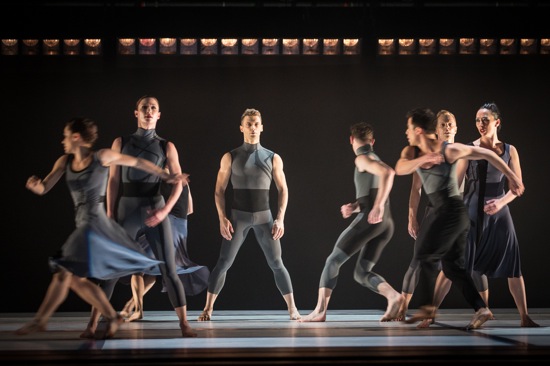
Larry Keigwin’s Rush Hour. Rushing past in the foreground: Eran Bugge (L) and Francisco Graciano. Identifiable behind them (L to R): Laura Halzack, Mochael Novack, Michael Trusnovec, and Christina Lynch Markham. Photo: Yi-Chun Wu
Keigwin deploys these superb dancers to convey the pressure and speed of city rush hour. They walk, run, and leap this way and that; maybe each is on his/her own track to the L train. Often they find themselves herding. They arrive from the dimness at the back and retreat to it. At various times, all or some of them freeze, collecting themselves amid the tumult. The music too has its silences.
Occasionally a vignette stands out; Michelle Fleet collapses after a short bout of dancing, and the horde passes her by, dangerously close and unseeing. However this is no realistic rush hour; it’s how this society lives. In the well-ordered, speeded-up hubbub, dancers run so fast they end up sliding along the floor. I think it was Kleinendorst who first crawled backward off the stage. Occasionally someone is dragged away. People may pair up briefly (with male-female partnering only one option), but relationships quickly dissolve. After a short encounter Graciano leaves Khobdeh on the floor and hastens on. Four travelers form a complicated tangle of moving forward and holding back (Graciano, Trusnovec, Novak, and Mahoney, as I recall); later the they do it again, with variations.
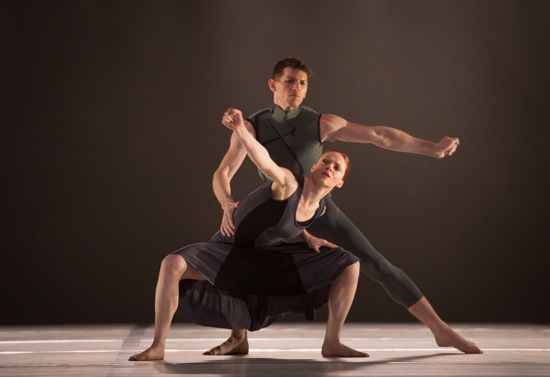
Heather McGinley and Sean Mahoney in Larry Keigwin’s Rush Hour. Photo: Yi-Chun Wu
In a choreographed version of shoving, various dancers plant themselves, feet wide apart; others hoist them a few inches off the floor and shift them to the side, then run around them to find their own places. Sometimes those lifted (stiff as dolls) immediately bounce back into their original spots. Keigwin positions these maneuvers in various places, at various angles and times.
The Taylor dancers attack his movement style with the expected intelligence and fervor. They’re not used to being so sinuous with their bodies. Keigwin has also occasionally asked them to execute such un-Taylorish moves as letting their heads pull them into movement. He contrasts straightforward efforts to push in one direction with evasive reactions, and pits the rhythms of rushing with pauses. It’s rare to see a subject that’s by nature haphazard keep choreographic order and the illusion of free will in balance. In the end, the bar of lights rises, and the only person left onstage (Fleet) is snatched backward into the dark.
The first two performances of the season included three major Taylor works: Mercuric Tidings, Esplanade, and Promethean Fire. Every time I see them, I notice some new facet of the choreography. The first time I saw the 1982 Mercuric Tidings, I was awed by its pressurized approach to excerpts from two Schubert symphonies (nos. 1 and 2). Two years ago, I was beguiled by the enigmatic scene that takes in Trusnovec and Halzack, enmeshed in a slow duet; three attendant nymphs (Ho, Khobdeh, and Jamie Rae Walker in the current cast); and Fleet. Sometimes Fleet stands and watches the goings-on in an almost schoolmistressly way, but occasionally steps in to grab one of the other women’s hands and dance them along in a chain.
This time, I realized that if you were to count the steps in the dance (the leaps, the sailing turns, the little sideways jumps with the feet beating together in the air, the bunched-up jumps, the skimming runs etc.), you would find the vocabulary to be fairly modest. But how remarkably Taylor molds these in space to create an image of immense vitality and richness in moderation—a moving garden that subtly mixes five or six varieties of roses.
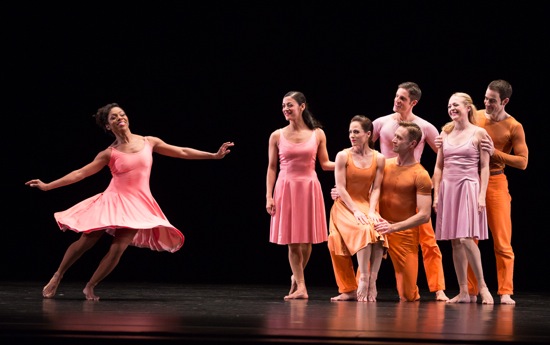
Paul Taylor’s Esplanade. Michelle Fleet watched by (L to R): Parisa Khobdeh, Eran Bugge, James Samson (kneelng), Michael Apuzzo, Jamie Rae Walker, and Robert Kleinendorst. Photo: Yi-Chun Wu
The simple vocabulary of the 1975 Esplanade is one of its beauties. Much of the choreography— set to movements from J.S. Bach’s Violin Concerto in E Major and his Concerto for Two Violins in D Minor—involves walking and running at various speeds, jumping, falling, and, in the second movement, restrained gestures that hint at a family’s scenario. You don’t see phrases made of steps strung together; you just see people traveling buoyantly along, as if the occasion were an excursion in a summer field. The wild running and falling during the last movement hurts no one; a wind came up, and they let it take them. The choreographic oddities are themselves enthralling: Fleet skittering forward and backward around the stage, her feet moving with the speed of a sewing machine; women leaping into their partners’ arms from a heart-stopping distance away; Bugge in a quiet duet with Kleinendorst stepping carefully onto his belly as he lies supine (pinned down, he can still lift both his upper body and his legs in response to her gestures). Think about that last image and all that it can convey.
Promethean Fire (2002) closed the second-night program. The Bach music so expertly conducted by the company’s musical director, Donald York, is Leopold Stokowski’s thunderous arrangement for orchestra of the composer’s Toccata and Fugue in D Minor, Prelude in E-flat Minor, and Choral Prelude BWV 680. The sound is heavier and darker than that along which Esplanade scampers and flies. The sixteen dancers—all dressed alike in Loquasto’s black outfits banded in slim bronze v’s and spirals—kindle movement in line with the Shakespeare quote in the program defining such fire as an element “that can thy light relume,” although not quite in tune with the bard’s original intent (the words are spoken by Othello thinking of Desdemona. Kill her and no Promethean fire can make her eyes light up again).
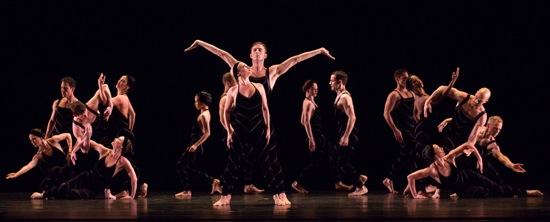
A tableau from Paul Taylor’s Promethean Fire. Center: Jamie Rae Walker and James Samson. Photo: Yi-Chun Wu
There’s something cataclysmic about this dance: the formations into which the dancers keep coalescing, the momentary heap of bodies, the way the men carry their partners away, as if depicting the legendary rape of the Sabine women. Trusnovec and Khobdeh, the leaders of this society, struggle in their duet; at times, she supports him. She clings to his ankle while he attempts to trudge forward and is dragged along by his every step, yet once they separate, she races back toward him and takes a dangerous vault into his receiving arms.
For all its storminess, the fact that the dancers often form tableaux that seem almost besieged by the music gives Promethean Fire the atmosphere of a ritual. Whether or not it can bring the dead to life, they must try to light it, and by their marvelous dancing they—metaphorically—do.
More next week. . . .

Rich with imagery for those of us not in the audience for these works.
I saw Dilly Dilly on Friday night and thought it just about the most charming thing I have seen in quite some time. It was one of those very rare dances that had me both smiling and close to tears the whole time. Grown up children caught up in play time as seen through a lens of nostalgia that only Paul Taylor could have conjured up. Burl Ives indeed! And what a sweet sound. Also saw Doug Elkins’ new piece on Thursday which I am sure you will comment on soon. I am eager to hear what you think as it took about 20 minutes for the 25 minute piece to catch fire and let the sometimes ribald Elkins humor shine through big time.
A well-informed review.